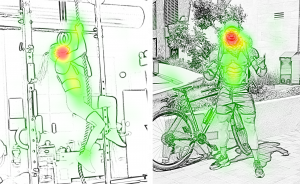Visual attention toward selected images from the instagram trend #fitspiration
Aim and Research Question(s)
This thesis is an exploratory observational pilot study, with the aim of analysing the attention of adolescents at upper secondary level towards images from the Instagram trend #fitspiration. Adolescents from upper secondary level schools were shown Fitspiration images while recording their eye movements using eye tracking.
Background
Trends on social media can have an impact on young people's health behaviours and body image, including the Instagram trend #fitspiration. Fitspiration aims at influencing people in a healthy way: influencers want to inspire their followers to lead a healthier lifestyle with posts about their fitness-driven lifestyles. Although the main objective of influencers is to evoke positive emotions, a negative self-perception of the own body image may still be caused due to posts often representing (edited) ideals of a body image [1], [2].
Methods
This study examines the visual attention of adolescents from upper secondary level schools in Vienna and Lower Austria when looking at #fitspiration images, using the eye tracking system Tobii Pro Nano. The study aims at observing the gaze behaviour between specific parts of the images as well as gender-specific differences.
Results and Discussion
The comprehensive analysis of the 32 adolescents' visual attention revealed that adolescents pay the most attention to the face, followed by nude body parts, especially the upper body. The following hypotheses were derived: First, when looking at #fitspiration images, adolescents direct particular attention to the face and those body regions that provide information about the shape of the body. Second, adolescents focuse their attention predominantly on Fitspiration images of their own gender, which most likely derives from a desire to identify oneself with the influencers.
 Figure 1: Heatmap of all participants
Figure 1: Heatmap of all participants
Conclusion
On social media, the portrayal of people often corresponds to an ideal body image due to beauty filters. This idealized representation of the body may lead to negative self-esteem. Having identified where adolescents draw their attention to when looking at Fitspiration images, these results may form a basis for future research in this area – analysing effects on the psyche, nutrition and sports behaviour after viewing such images or particular image sections. Furthermore, the results may form a basis for studies in the areas of body self-awareness and body positivity, with the aim of supporting adolescents when it comes to learning how to deal with beauty-filtered images.
References
[1] M. Tiggemann and I. Anderberg, ‘Muscles and bare chests on Instagram’, Body Image, vol. 35, pp. 237–244, Dec. 2020, doi: 10.1016/j.bodyim.2020.10.001. [2] M. Tiggemann and M. Zaccardo, ‘Exercise to be fit, not skinny’, Body Image, vol. 15, pp. 61–67, Sep. 2015, doi: 10.1016/j.bodyim.2015.06.003.
